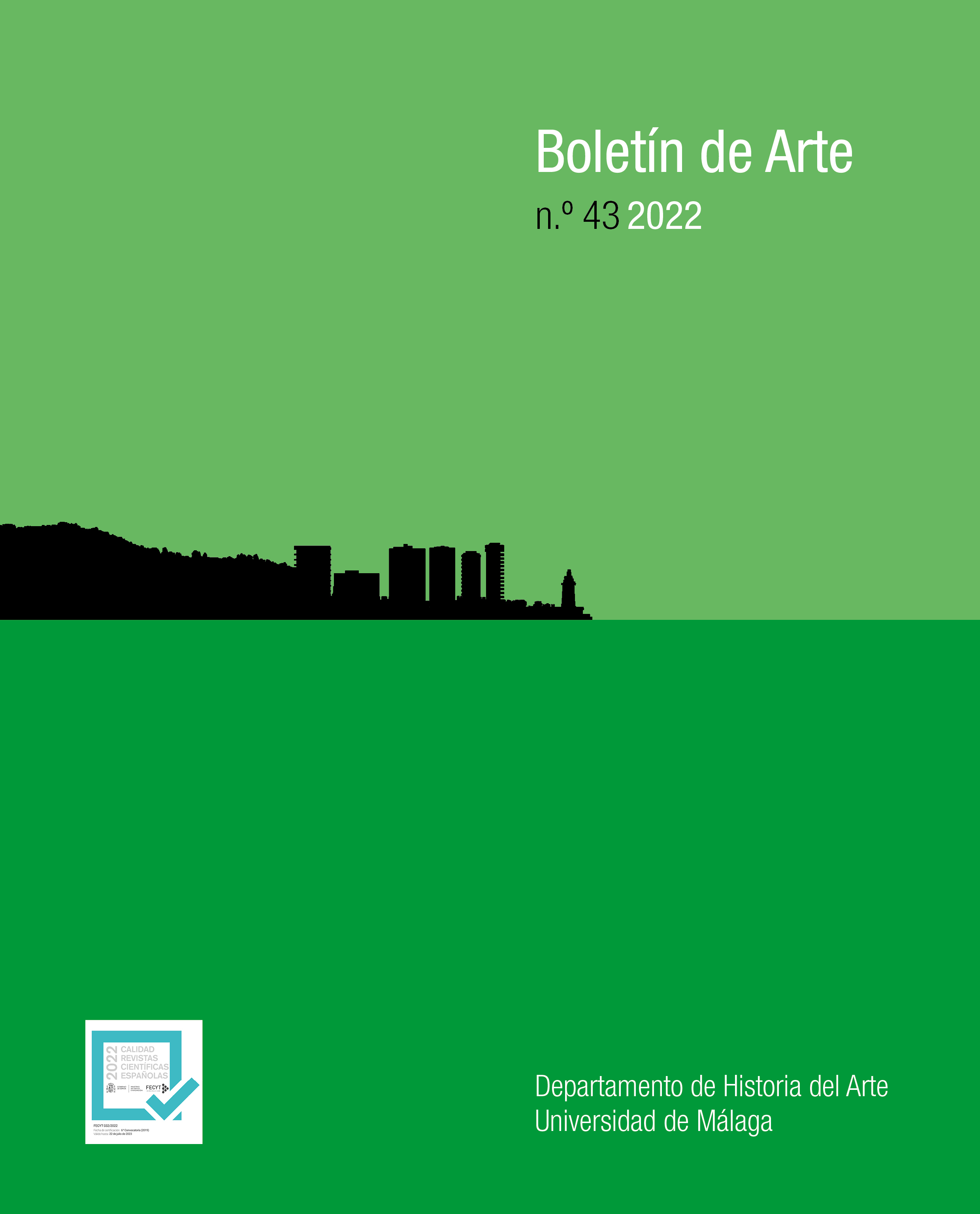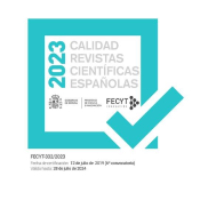Blessed Be the Fruit: santa Brígida y las resignificaciones religiosas en el referéndum sobre el aborto en Irlanda
DOI:
https://doi.org/10.24310/BoLArte.2022.vi43.14381Palabras clave:
Santa Brígida, Megan Scott, Olivia Harris, Octava Enmienda, Aborto, Nacionalismo, Irlanda, Artivismo, Arte feministaResumen
La fotografía de Olivia Harris, Blessed Be the Fruit, muestra a santa Brígida de Kildare, patrona de Irlanda, sujetando una pancarta en apoyo a la derogación de la Octava Enmienda de la Constitución de dicho país. Esta performance se inscribe en el clima previo al referéndum que tuvo lugar en 2018 en la República de Irlanda para decidir si se revocaba la ley que prohibía la interrupción voluntaria del embarazo. Esta fotografía y otras manifestaciones artísticas constituyen la base para realizar un estudio sobre la identidad nacional de Irlanda y sobre la figura de santa Brígida, personaje doblemente resignificado: primero por la apropiación del cristianismo, luego por el activismo feminista pro-elección.
Descargas
Métricas
Publicación Facts
Perfil de revisores N/D
Información adicional autores
Indexado: {$indexList}
-
Indexado en
- Sociedad Académica/Grupo
- N/D
- Editora:
- Universidad de Málaga.
Citas
ALEXANDROVA, Alena (2017), Breaking Resemblance: The Role of Religious Motifs in Contemporary Art, Fordham University Press, Nueva York.
BBC (2013), «Irlanda y el drama de las lavanderías de las Magdalenas», 6 febrero. En: <https://www.bbc.com/mundo/noticias/2013/02/130205_lavanderias_magdalena_irlanda_irm> (fecha de consulta: 20-02-22).
BBC (2016). En: <https://www.bbc.com/news/blogs-trending-37156673> (fecha de consulta: 24-02-22).
BEDOYA, Juan (2010), «Ella como pecado», El País, 3 septiembre. En: <https://elpais.com/diario/2010/09/03/sociedad/1283464801_850215.html> (fecha de consulta: 20-02-22).
BERGER, Pamela (1985), The Goddess Obscured: Transformation of the Grain Protectress from Goddess to Saint, Beacon Press, Boston.
CALLAN, Maeve (2012), «Of Vanishing Fetuses and Maidens Made-Again: Abortion, Restored Virginity, and Similar Scenarios in Medieval Irish Hagiography and Penitentials», Journal of the History of Sexuality, vol. 21, n.º 2, pp. 282-296. DOI: 10.1353/sex.2012.0031.
CAMPO DEL POZO, Mercedes del (2014), «“Mother Ireland, get off our backs”: Gender, Republicanism and State Politics in Prison Short Stories by Northern Irish Women Writers», Estudios Irlandeses: Spanish Journal of Irish Studies, n.º 9, pp. 13-23. https://doi.org/10.24162/EI2014-3923.
CHAN, Suzanna (2018), «Speaking of Silence, speaking of art, abortion and Ireland», Irish Studies Review, vol. 27, n.º 1, pp. 73-93. https://doi.org/10.1080/09670882.2018.1560892.
CONNOLLY, Sean; PICARD, J.M. (1987) «Cogitosus’s ‘Life of St Brigit’ Content and Value», The Journal of the Royal Society of Antiquaries of Ireland, vol. 117, pp. 5-27.
CONSTITUTE PROJECT (2021), «Constitución de Irlanda, 1937, con enmiendas hasta 2015», 26 agosto. En: <https://www.constituteproject.org/constitution/Ireland_2015.pdf?lang=es> (fecha consulta: 15-01-2022).
DE LA VORÁGINE, Santiago (2017), La Leyenda Dorada, vol. 2, Alianza, Madrid.
DEEPWELL, Katy (2020), Feminist Art Activisms and Artivisms, Plural, Amsterdam.
ESPOSITO, Mario (1912), «On the Earliest Latin Life of St. Brigid of Kildare», Proceedings of the Royal Irish Academy: Archaeology, Culture, History, Literature, vol. 30, pp. 307-326.
FIELD, Luke (2018), «The Abortion Referendum of 2018 and a Timeline of Abortion Politics in Ireland to Date», Irish Political Studies, vol. 33, n.º 4, pp. 608-628. https://doi.org/10.1080/07907184.2018.1500461.
IRISH STATUE BOOK. En: <https://www.irishstatutebook.ie/eli/1983/ca/8/enacted/en/print#sec1> (fecha consulta: 10-01-22).
KISSING, Elizabeth (2018), From a Whisper to a Shout: Abortion Activism and Social Media, Repeater Books, Londres.
LACHOWSKYJ, Cat (2019), «Blessed Be the Fruit», Lensculture. En: <https://www.lensculture.com/articles/olivia-harris-blessed-be-the-fruit> (fecha de consulta: 15-01-22).
LENTIN, Ronit (2013), «A Woman Died: Abortion and the Politics of Birth in Ireland», Feminist Review, n.º 105, pp. 130-136. https://doi.org/10.1057/fr.2013.21.
LYONS, Laura (1996), «Feminist Articulations of the Nation: The ‘Dirty’ Women of Armagh and the Discourse of Mother Ireland», en KIBBEY, Ann, FOSTER, Thomas, SIEGEL, Carol y BERRY, Ellen (eds.), On Your Left: Historical Materialism in the 1990s, New York University Press, Nueva York, pp. 100-149.
MARTIN, Angela K. (1999), «Death of a nation in Ireland. Transnationalism, bodies and abortions in late twentieth-century Ireland», en MAYER, Tamar (ed.), Gender Ironies of Nationalism. Sexing the Nation, Routledge, Londres. https://doi.org/10.4324/9780203013236.
Mc CARTHY, Daniel (2000), «The chronology of St Brigit of Kildare», Peritia, n.º 14, pp. 255-281.
Ó DUINN, Sean (2005), The Rites of Brigid: Goddess and Saint, Columba Press, Dublín.
PARLAMENTO EUROPEO. En: <https://www.europarl.europa.eu/about-parliament/es/in-the-past/the-parliament-and-the-treaties/maastricht-treaty> (fecha de consulta: 18-02-22).
RALPH, David (2020), Abortion and Ireland: How the 8th Was Overthrown, Palgrave Pivot, Basingstok.
RÉAU, Louis (2000), Iconografía del Arte cristiano, Iconografía de los santos, Tomo 2, vol. 3, Ediciones del Serbal, Barcelona.
REUTERS STAFF (2009), «Sacerdotes irlandeses pegaron y violaron niños, según un informe», Reuters, 20 mayo. En: <https://www.reuters.com/article/oestp-irlanda-abusos-iglesia-idESMAE54J0Q820090520> (fecha de consulta: 24-02-22).
RODRÍGUEZ PLASENCIA, José Luis (2012), «El culto a Santa Brígida en Extremadura», Alcántara: revista del Seminario de Estudios Cacereños, n.º 75, pp. 21-43.
SCARLATA, Jessica (2016), Rethinking Occupied Ireland: Gender and Incarceration in Contemporary Irish Film, Syracuse University Press, Syracuse.
SMITH, James M. (2007), Ireland’s Magdalen Laundries and the Nation’s Architecture of Containment, University of Notre Dame Press, s.l.
Publicado
Cómo citar
Número
Sección
Licencia
Todos los contenidos publicados en la revista Boletín de Arte están sujetos a la licencia Creative Commons Reconocimento-NoComercia-Compartirigual 4.0 cuyo texto completo puede consultar en <http://creativecommons.org/licenses/by-nc-sa/4.0>

Los/as autores/as cuyas contribuciones sean aceptadas para su publicación en esta revista conservarán el derecho no exclusivo de utilizar sus contribuciones con fines académicos, de investigación y educativos, incluyendo el auto-archivo o depósito en repositorios de acceso abierto de cualquier tipo.
La edición electrónica de esta revista esta editada por la Editorial de la Universidad de Málaga (UmaEditorial), siendo necesario citar la procedencia en cualquier reproducción parcial o total.












4.png)
